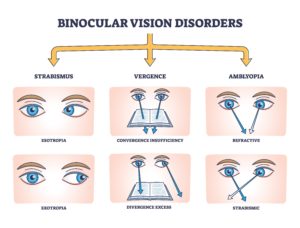If you wear eyeglasses or contact lenses for farsightedness and then remove them, can you see? We know you can’t see long distances, but can you read a book? Can you play a game on your phone? See the time on your watch? Technically, it should be “close enough” for you to see, but you notice something strange happening that causes the numbers and letters to overlap. If you experience this, it can be troublesome and frustrating, but you’re not alone. It’s a common condition known as convergence insufficiency.
Although convergence insufficiency often affects eyeglass and contact lens wearers, some people are born with the condition. Others may have 20/20 vision and still experience it. In fact, studies show that up to 13 percent of the population has it.
So what is it exactly?
Table of Contents
What is Convergence Insufficiency?
Generally, convergence insufficiency is when your eyes don’t know how to work with each other as well as they should in order to help you see things that are up close. In other words, the eye muscles aren’t as strong as they should be to do what they’re supposed to do for you.
As a result, when someone who has convergence insufficiency tries to see something up close, one eye moves too far toward the temple, almost as if it’s running away from the other eye and leaving it to do all the work. This misalignment in vision creates a multitude of temporary issues, including momentary cross-eyed vision, blurry vision, or jumbled letters and numbers on the object in front of you.
Symptoms of Convergence Insufficiency / Convergence Deficiency
Someone who is living with convergence insufficiency, also known as convergence deficiency, knows some of the symptoms well and just learns to “deal with it.” In many cases, it may be considered a simple annoyance. However, convergence deficiency has many symptoms, many of which the person might not even realize is caused by the condition. They include:
- Headaches
- Blurry or double vision
- Frequent loss of place when reading
- Words appear to move, jump, swim, or float
- Motion sickness
- Vertigo
- Short attention span
- Squinting, rubbing, or covering one eye in order to see better
- Learning problems
Causes of Convergence Insufficiency
The causes of convergence deficiency are unclear, but heredity, injury, and diseases are possibilities that scientists are exploring. In situations where the disorder begins in adulthood, some eye doctors theorize that the eyes have become dependent on eyeglasses or contact lenses and therefore have lost some of their ability to work together. Use of the corrective lenses, however, is still critical for obvious reasons, but talk with your eye doctor about your options.
Convergence Insufficiency Treatment
For people who have just learned to live with it, there’s good news. The condition can be treated with eye exercises, but like any other form of exercise, you have to do it in order to reap the results.
One common eye exercise to treat convergence insufficiency is pencil pushups, in which you hold a pencil out vertically at arm’s length and slowly bring it toward your nose until your eyes can no longer focus. You would then bring the pencil back out and back to your face again until you can bring it closer than you did before. The goal is to “train” your eyes to work together until you can bring the pencil to a reasonable distance from your face.
Another is a similar exercise but with the use of a light pen that many eye doctors may have available for you.
For more information about convergence deficiency treatment, contact your local eye doctor or one of our Michigan Eye Institute offices throughout Genesee County.
Comments are closed.




